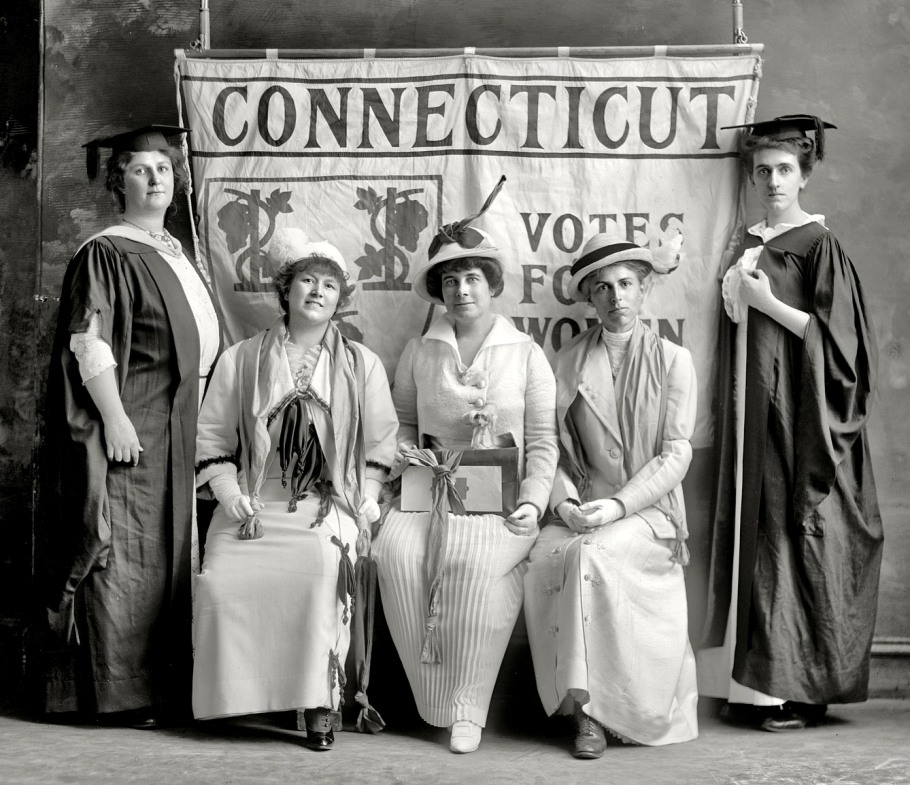The 19th Amendment to the Constitution guarantees all women who are US citizens the right to vote. The bill became a law in the first decades of the 20th century, but the fight for woman suffrage began decades earlier. It was a difficult campaign with varying strategies that not only divided the nation but also created fractures within the movement itself. While national organizations fought well-publicized battles in the courts, states like Connecticut organized to debate the issue at the regional, state, and even town and city levels.
The start of the fight for woman suffrage often traces its roots to the “Declaration of Sentiments” drawn up at the women’s rights conference in Seneca Falls, New York, in 1848. The decade that followed witnessed such pioneers as Elizabeth Cady Stanton and Susan B. Anthony emerge as the face of a movement that furthered their cause through letter-writing campaigns, marches, and acts of civil disobedience.
The Connecticut Woman Suffrage Association
In Connecticut, Frances Ellen Burr and Isabella Beecher Hooker took up the cause by forming the Connecticut Woman Suffrage Association (CWSA) in 1869. Hooker, the daughter of famed preacher Lyman Beecher and sister of author and activist Harriet Beecher Stowe, served as the organization’s director for 36 years.
Meetings of the CWSA, like the one held on November 14, 1871, in New London, served a number of important purposes in the fight to get women the vote. First, the meetings attracted new members and solicited pledges from these members to organize similar organizations at the town and city level. Additionally, it allowed organizers to keep members informed about relevant events transpiring across the country and assess their impact on more local efforts. Finally, these meetings also allowed for far-reaching organization and, consequently, allowed CWSA leaders like John Hooker and Harriet Beecher Stowe of Hartford, the Reverend Phoebe Hanaford of New Haven, Mr. and Mrs. George Cheney of Manchester, and the Reverend Olympia Brown of Bridgeport to more effectively coordinate large-scale demonstrations and mailing campaigns.
1878 Defeat at Federal Level Spurs Renewed Action
In 1878, Congress defeated a proposed amendment to the Constitution guaranteeing women the right to vote. (It was an amendment that resurfaced unsuccessfully every year for the next 40 years.) The defeat in Congress, in the wake of a similar setback in the Supreme Court just a few years earlier, encouraged suffragists to look to state organizations for leadership, hoping to garner enough support (one state at a time) to strengthen future appeals at the federal level.
By the start of the 20th century, however, Connecticut, like much of the nation, remained divided on the issue. Some proponents of change advocated letter-writing campaigns and peaceful demonstrations, while others took the increasingly radical approach of promoting hunger strikes and more confrontational acts of civil disobedience.
Others publicly bristled at the idea of granting women the right to vote. The Connecticut Association Opposed to Woman Suffrage argued that much of the social progress gained by women in prior decades created additional burdens for women and that the responsibility for voting only added to these burdens. It was the feeling of the organization’s leaders that voting rights might also compromise the nonpartisan sentiments women needed to serve as the world’s great reformers.
But proponents of woman suffrage saw it as their responsibility to push the constitutional amendment through so that they might, among other things, have a louder voice on issues of reform, such as temperance. By the second decade of the 20th century, this voice was indeed getting louder. In 1917, membership in the CWSA was over 32,000 (compared to just 288 in 1871) and members were ready to turn up the pressure on the federal government.
On July 12, 1918, frustrated by the opposition to woman suffrage displayed by Connecticut senators George McLean and Frank Brandegee, suffragists rallied in Hartford and Simsbury to take their appeal directly to President Woodrow Wilson. The rally’s organizers wrote a telegram to the president in hopes of winning his support. The pressure coming from Connecticut, and states across the country, eventually convinced President Wilson to change his position on woman suffrage.
Finally, on May 21, 1919, the US House of Representatives passed the 19th amendment—followed shortly after by approval in the Senate. Ratification came on August 18, 1920, and just over a week later, Secretary of State Bainbridge Colby certified it, officially granting women in the United States the right to vote.











